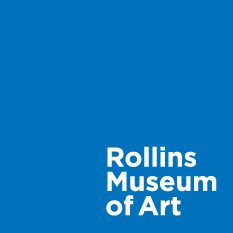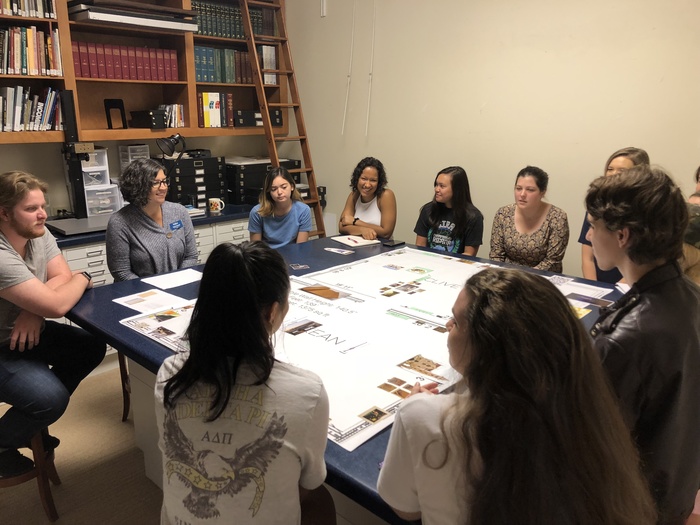By MacKenzie Moon Ryan, Ph.D., Assistant Professor of Art History and Gisela Carbonell, Ph.D., Curator.
Last fall, the Cornell Fine Arts Museum worked closely with Dr. MacKenzie Moon Ryan, Assistant Professor of Art History at Rollins, and her ARH 404 Museum Studies Practicum class on an exhibition that proposes dialogues across cultures, time periods, and media. The Place as Metaphor: Collection Conversations, on view through May 12, includes more than 50 works from the museum’s permanent collection and is enhanced by a few key loans from private collections and from Art Bridges. Displayed across two adjacent galleries, the exhibition is an invitation to reflect on what the notion of place means to us. How we experience place (in its multiple definitions) may depend on many factors, and the works on display consider these ideas from multiple points of view.
Dr. Ryan’s students worked in tandem with CFAM’s curator, Dr. Gisela Carbonell, and with members of the staff as they learned about the “behind the scenes” of museum exhibitions. From researching and writing about specific pieces, performing condition reports, providing input on placement, and selecting wall color to proposing thought-provoking pairings, students learned by doing. This was a fantastic opportunity for collaboration and for students to share the product of their learning experience with the community at large. Now that the exhibition is open, Dr. Ryan and Dr. Carbonell reflect on the collaborative nature of this project and its impact on the students.
GC: Working in partnership with you and your students in the context of the Museum Studies Practicum was a fantastic experience, and a good reminder that curatorial work, especially in an academic setting, must always prioritize education as a goal. What are some of the greatest takeaways of this experience for you and for the students?
MMR: For my students, I think one of the greatest takeaways of our collaboration was how much work goes on behind the scenes to make an exhibition come to life. They learned about the various roles of museum staff members and then worked with, alongside, or in the shadow of each of them. For example, students conducted condition reports under the watchful eye of Austin Reeves, Exhibition and Collections Manager. They also tried their hand at curating in researching artworks, penning didactic labels, and pitching dynamic artwork pairings, with you, the curator, as their model. While their finished assignments encompassed only 130 words or an eight-minute oral presentation, the sheer amount of research, writing, editing, and rehearsing necessary taught students about what it takes to achieve the professionalism and academic rigor of well-researched exhibitions and supporting programming.
 For me as the professor of Museum Studies Practicum, my greatest takeaway was seeing students discover the behind-the-scenes world of museums. As junior and senior art history majors, most all students are regular museum-goers, but few had previous experiences like the ones you and I were able to offer through this class. It was gratifying to see students envision a wider array of future careers in art history!
For me as the professor of Museum Studies Practicum, my greatest takeaway was seeing students discover the behind-the-scenes world of museums. As junior and senior art history majors, most all students are regular museum-goers, but few had previous experiences like the ones you and I were able to offer through this class. It was gratifying to see students envision a wider array of future careers in art history!
GC: As curator, I get excited about works of art that speak to me, either visually or thematically or both. Spending time with the piece and researching and learning about it sometimes feels like getting to know a new friend. Some of the students shared why they were drawn to a specific work and it seems like many of them experienced a connection, and identified with a topic or artist by engaging with art. As an educator and a mentor, how would you characterize the impact art can have on a student’s learning experience in the context of this class and beyond?
MMR: I think art has a transformative quality that can transcend time and space. Visually arresting imagery can stop time just for a moment, capturing a feeling or a conversation between the work of art and the viewer. Art can also transport the viewer back to its moment in time, with a little help from researching its historical and cultural background. To that end, when a student spends minutes, hours, days, and perhaps weeks researching a piece, looking closely and apprehending each detail, as Museum Studies Practicum students have, I think it is natural that a bond forms between the two. These paintings, sculptures, and objects will remain with students long beyond the confines of this class.
GC: The Place as Metaphor addresses the notion of place from diverse perspectives and examines issues such as immigration, land ownership, identity, and devotion, among others. Working within these thematic frameworks required students to think across disciplines. Did you find that some of these themes resonated more than others? How did students navigate their thematic interests and the hands-on components of the course?
MMR: I was impressed that different themes appealed to different students. We had a fairly even distribution of themes and objects. The students also selected different works depending on the assignment or hands-on component. For example, [some] students picked their favorite work to research in order to write a 130-word didactic label for inclusion in the gallery. On the other hand, [some] students began with an overarching theme and then selected supporting objects in order to create their gallery guides. Finally, after spending time and effort researching and writing about a work of art for a didactic, their inquiry into subject matter, larger contextual issues, or points of view raised different questions that could be further mined in the artwork pairings or object dialogues, their final oral presentations. Some students selected quite the novel pairings and raised insightful points about the meaning made, or the conversation possible, between two works that adorn the walls of Place as Metaphor.
 GC: Certain aspects of an exhibition may change and evolve as it develops and sometimes adjustments need to be made in the process. How did the group’s engagement with the exhibition change throughout the semester?
GC: Certain aspects of an exhibition may change and evolve as it develops and sometimes adjustments need to be made in the process. How did the group’s engagement with the exhibition change throughout the semester?
MMR: Naturally, some students were disappointed when we made cuts to the checklist, but these changes to the selection included in Place as Metaphor provided fruitful topics for discussion. We interrogated why each work could be omitted without sacrificing any of the thematic groupings or the overall exhibition’s organizational principle. Some of the cuts, you’ll recall, were also practical — some had been on view recently and needed to rest while others were too big for the gallery walls to accommodate without cutting many other works. These considerations were excellent for students to learn about, again driving home the message that exhibition creation is collaborative and we rely on our colleagues to best guide us. Throughout the course of the semester, students felt more and more ownership of Place as Metaphor; now that the exhibition is on view, it is thrilling for them (and me!) to point to different locations in the galleries and say, “I did that!” That tangible contribution, subsumed into a professional CFAM exhibition, is evidence of the successful collaborative nature of this project.
MMR: Thank you for the opportunity to integrate art history majors into the fabric of life at CFAM. I look forward to future collaborations and iterations of Museum Studies Practicum!

